There’s been racing at Warrnambool since the mid 1850s, though the two vintage grandstands on the course today date from early to mid 20th century. Lots of drama here over the years.
My experience at the races
There are two vintage grandstands at Warrnambool racecourse, though it’s quite hard to tell when either of them was built, and I have a feeling one is quite a bit more recent than the other.
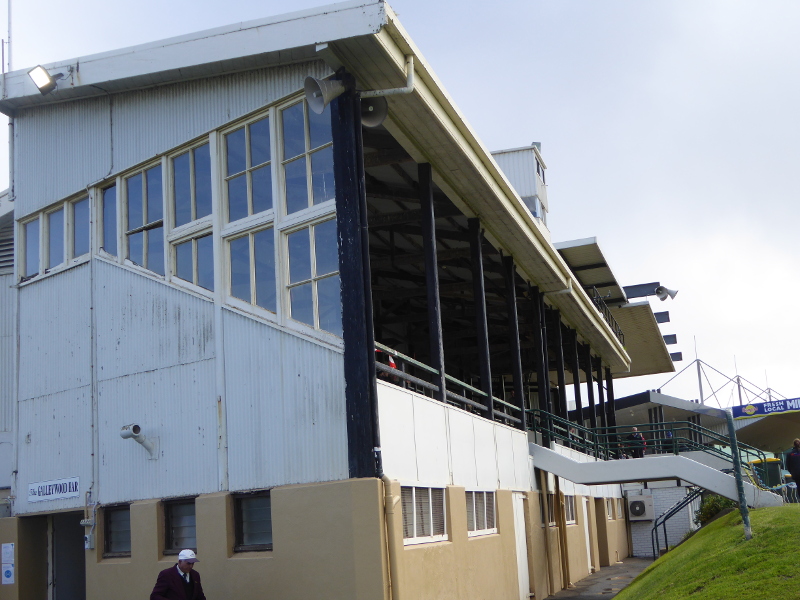
Most racegoers these days, though – at least on the wet winter’s day I was there, with the crowd quite small – sit in the more modern grandstands that sit between the two older ones: they are both nearer the finishing post, and one at least looks quite a bit more comfortable than the vintage benches I enjoy!
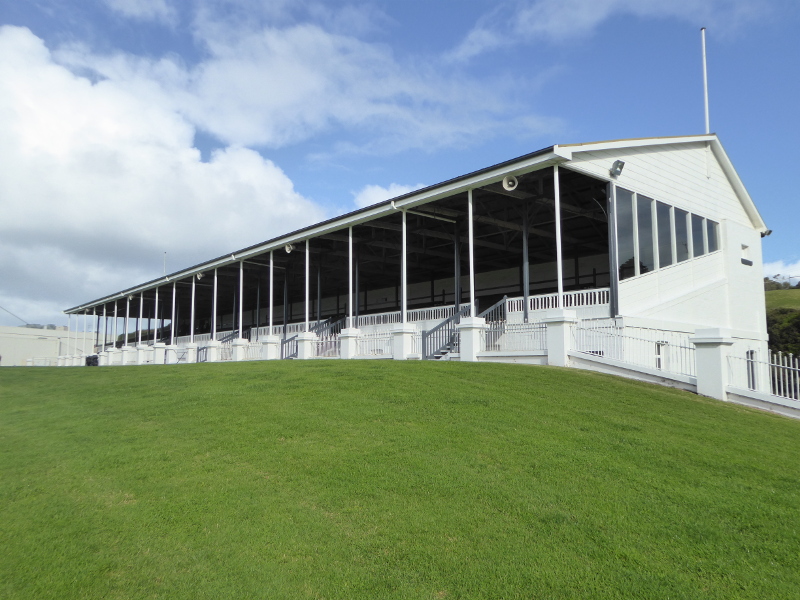
The one I sat in for most races must seat about 750, though only one big family plus a few oddball loners like me were there for this race day. It may well be the grandstand built around 1910, though there is no signage, and the descriptions in the newspapers when that grandstand opened did not go into enough details for me to compare.
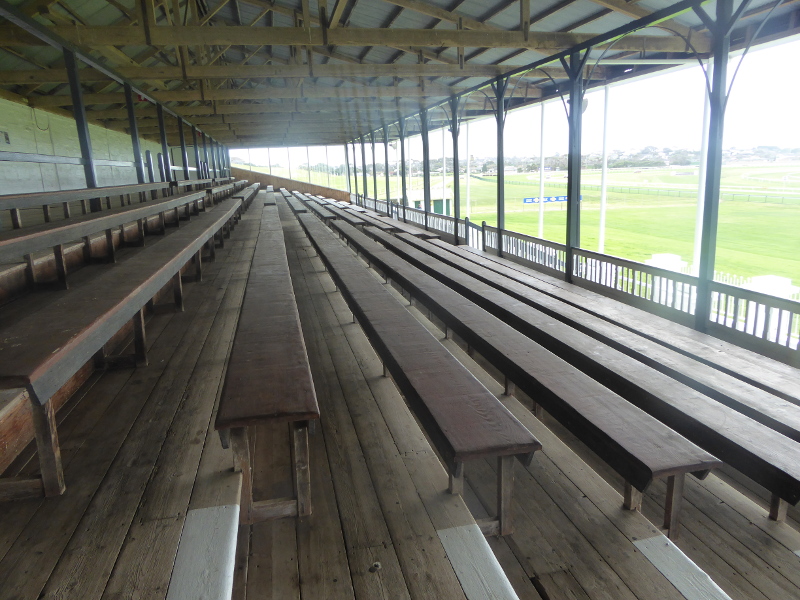
However, the very fact that those news clippings in 1909-10 didn’t describe in detail the new structure might also be a clue, because it does lack the glamour and extravagance of grandstands nearby at Camperdown or Hamilton.

There are ten rows of simple benches, with five staircases leading up from the grassy space below.
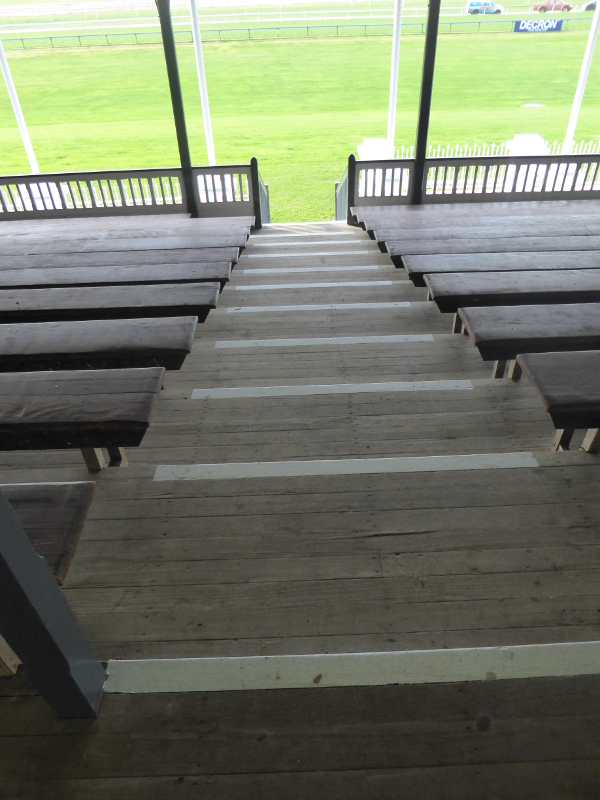
It may well have been in this grandstand that the lady tripped on a loose stair plank in the 1950s, causing a bit of a stir at the time. The stairs seemed pretty solid to me, but it is a fair way down if you tripped…
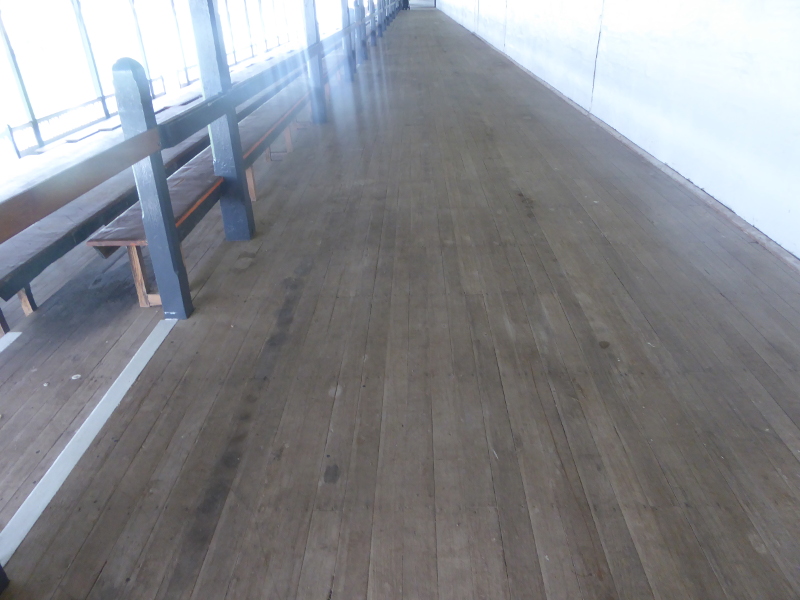
At the back of the grandstand is a wide walking – or standing – area, being used by kids in 2021 to chase each other along, but presumably built as an overflow when those benches were full to capacity.

The grandstand has a fairly simple design, with a series of semi-circular arcs over the ten or so sections being the extent of the decoration.
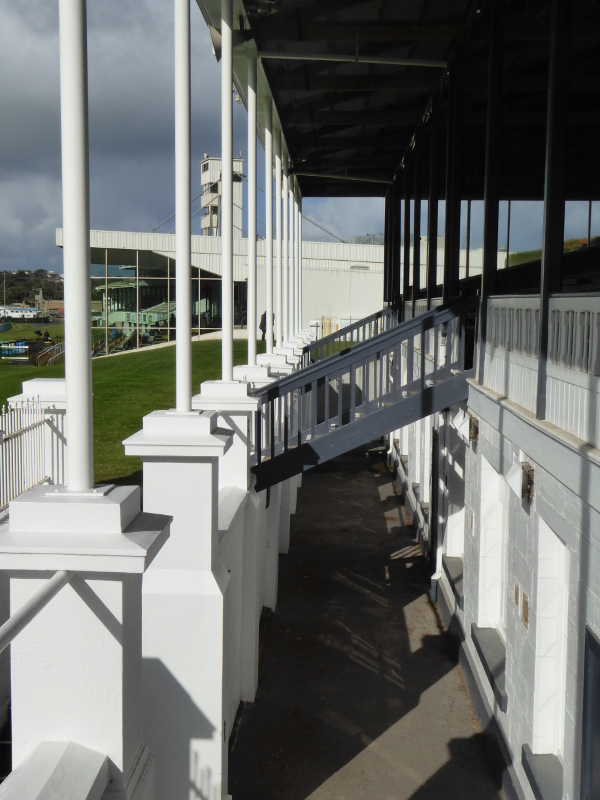
The five staircases extend out like flying buttresses on a big church, passing over what was probably once the path to the luncheon rooms in the area below the grandstand.
The white iron fence and the stone posts make an impressive frontage to the grandstand, and I rather liked the series of vertical metal posts forming the protective framework for the façade.
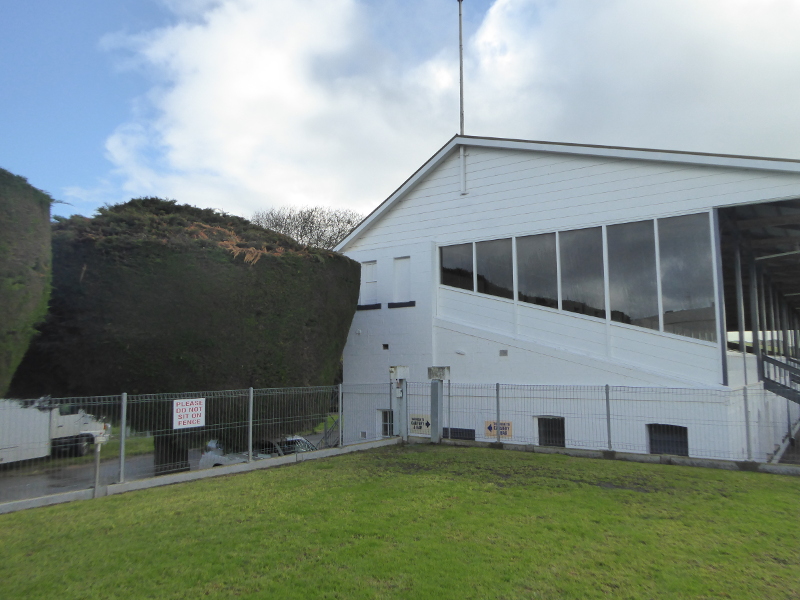
From the side angle, the grandstand is really quite attractive.
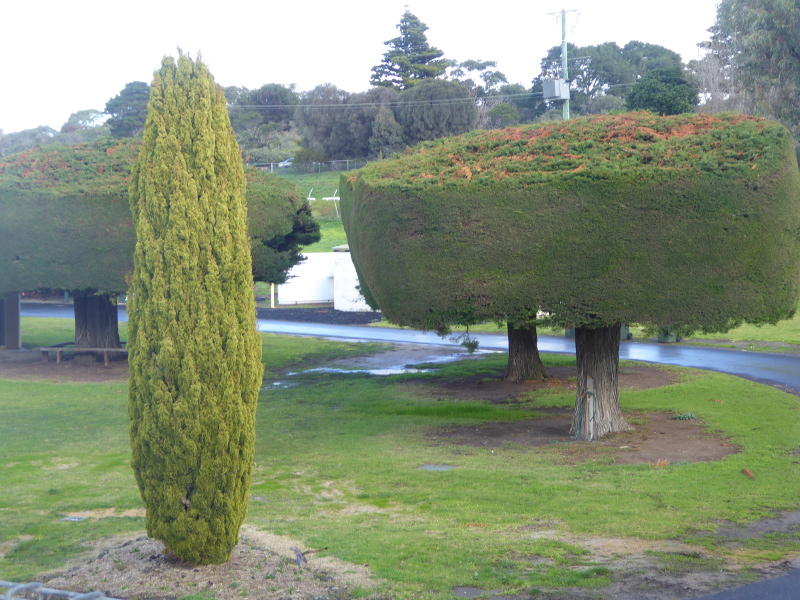
The carefully manicured conifers that line up behind the various grandstands are not really to my taste, but they look as if they have been there for quite a while now.
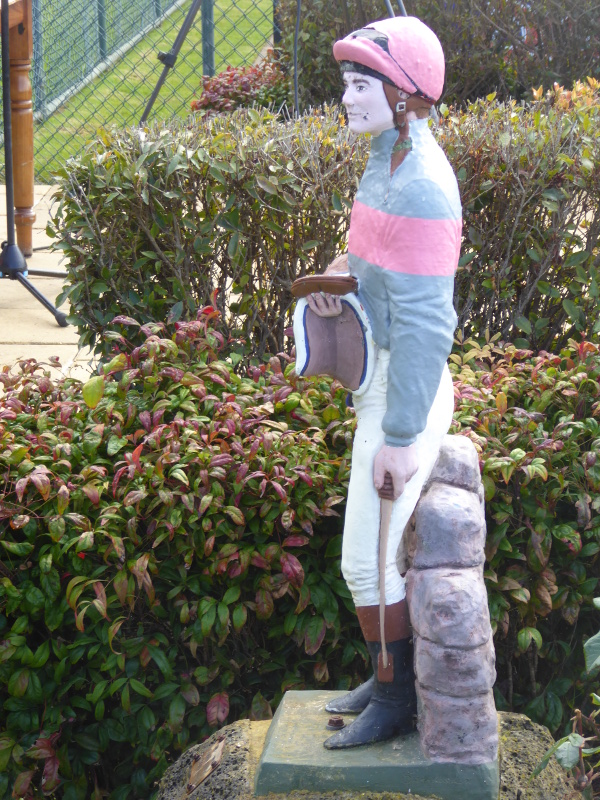
In front, by the parade ring and winners enclosure is this small model of a jockey, but since this seemed to be a members only area, I didn’t get a chance to look closely and see who it is supposed to be. Does anyone know? Is it just a generic ‘model of a jockey’ or is it supposed to commemorate someone in particular, and if so, who?
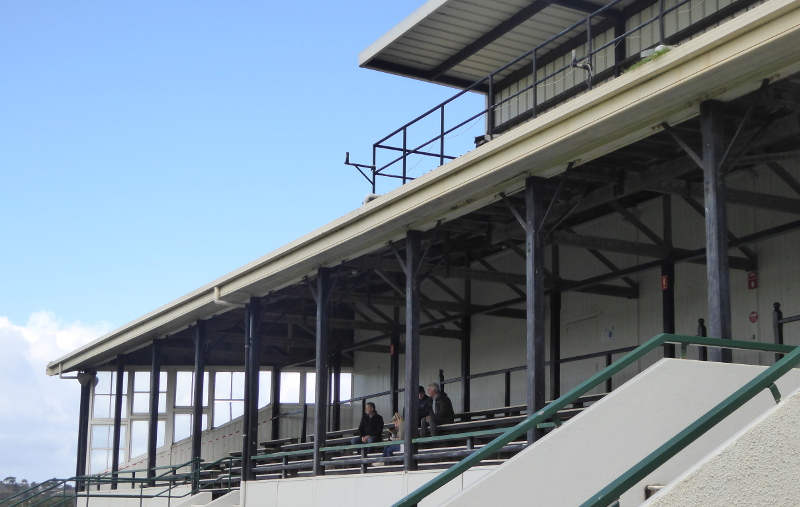
The other grandstand is beyond the finishing line, and seemed to be frequented mainly by people associated with the various runners.
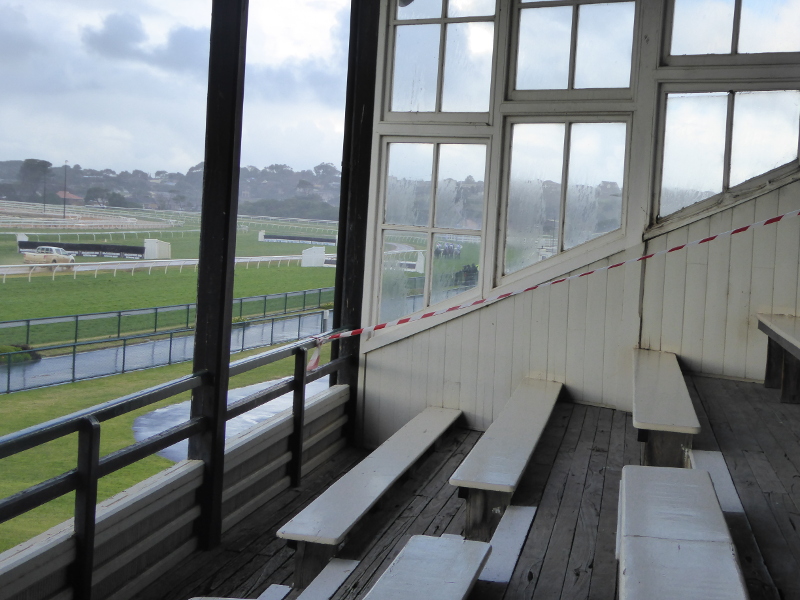
I think this grandstand is more recent than 1910, possibly built as late as the 1950s, but it still counts as vintage in my definition, with more simple benches.
And some quite nice wooden-framed windows in the side. Can anyone fill me in on when this grandstand was built?
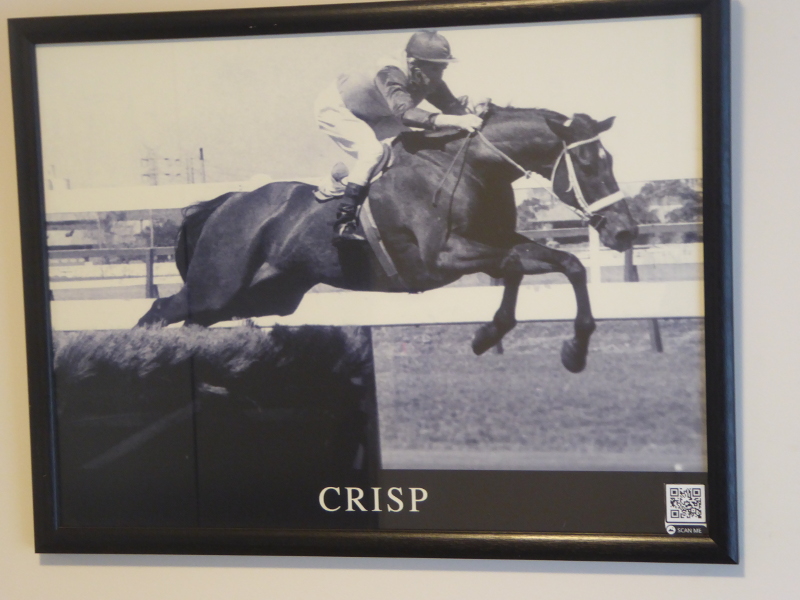
I liked the photos that hang on the walls all round the public bar area. A lot of the names of horses and jockeys or trainers didn’t mean much to me this time, but one horse I did recognise. Crisp was – I believe – trained originally near here at Coleraine (or Casterton?) – but of course to many Brits it is famous for being the unfortunate horse that ran out of puff right at the end of the Aintree Grand National in 1973 (?), when Red Rum won the first of three Nationals.
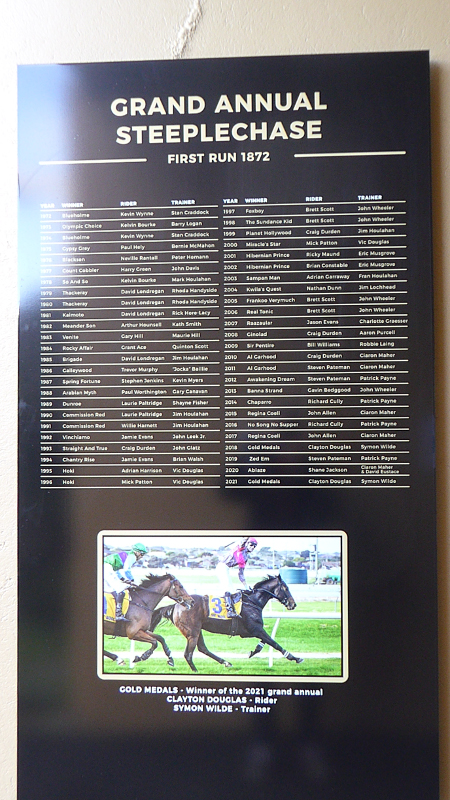
Warrnambool is home to the Grand Annual Steeplechase, and has been since 1872 (??), though I could have sworn in my history search that that race too was once called the ‘Grand National’.
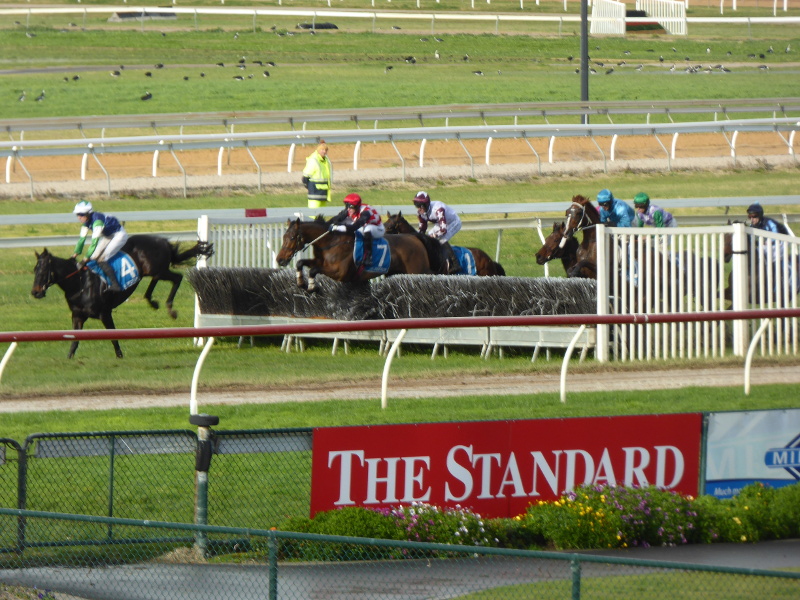
My day at the Warrnambool races was also a steeplechase day, with all the races I saw over jumps.
The steeplechase course takes an unusual shape, as the horses do a kind of figure of 8, starting off appearing to run clockwise (as the original Warrnambool track as a whole did, apparently), but then switching to anti-clockwise (or right-handed) by the finish.
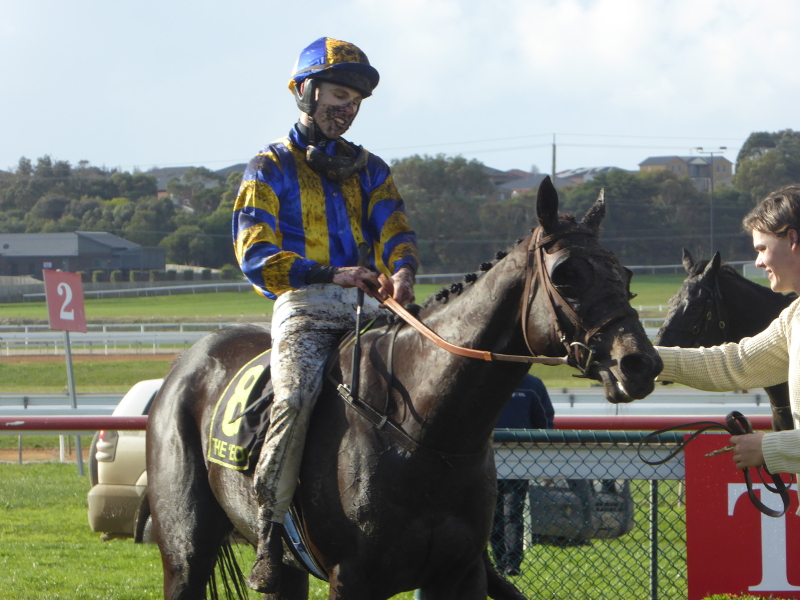
It was about as wet as it can be before they cancel race meetings. The going was heavy, it was heavy going also just getting through some of the races. And boy was it muddy for both horse and jockey just getting round the track…
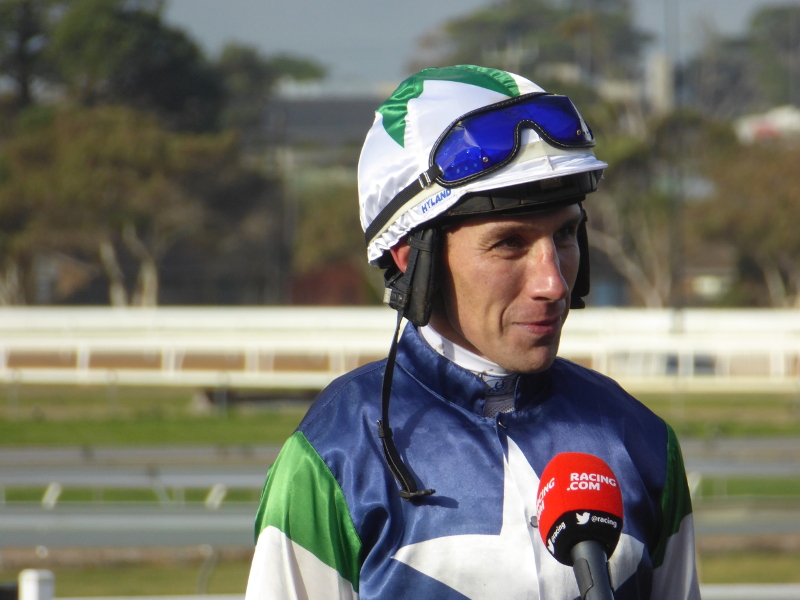
The best way to do it and stay clean was clearly to lead all the way, as this winning jockey in the big race managed it. William McCarthy was his name, I think, and he had just won his share of the $250,000 prize-money on offer for that big race. Not a bad day at the office…
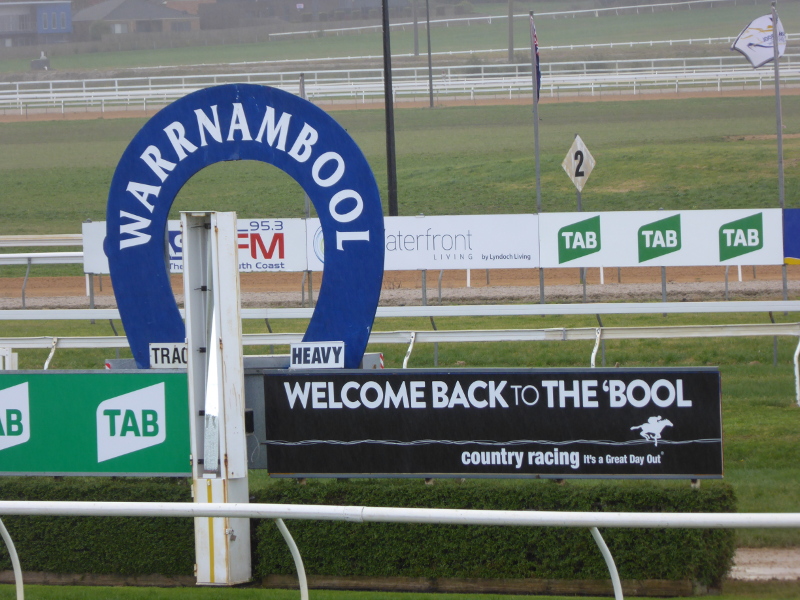
I didn’t back his mount, but for a change, I did come out on top in my own betting over the course of the day. So, all in all, a good day at the races, and two vintage grandstands for the price of one. Thanks The ‘Bool…
Practicalities
Course is just north of the main A1 Princes Highway, which cuts through the town. Well sign-posted; parking looked fairly limited but I did manage to get a spot.
$20 entrance on the day.
History and stories from Warrnambool racecourse
In 1855 they were still marking out the distance posts. 1858 saw the first races on the present course, though all the facilities and finishing post were on the other side of the track back then.
In 1859 a big amateur steeplechase – 6 runners, all finished – one fell but got straight back up; helped by not having horsemen ride alongside the runners, a common sight at many meetings all those years ago.
The first grandstand, an impressive beauty judging by the sketch in the newspapers, was built in 1875 – it’s not clear when it was pulled down, though.
In 1882 the Warrnambool steeplechase course was described as the best in Australia – The Illustrated Australian News carried a beautiful sketch of the ‘new grandstand’ on 22 March 1882.
It is claimed in some parts that the tune of ‘Waltzing Matilda’ was first heard in Australia at the Warrnambool Racecourse in 1894, when the local brass band played a Scottish tune, which was later set to words by Banjo Paterson. Nice claim to fame, if so…
Tragedy struck in 1900, when a 24 year old jump jockey known as ‘Jumbo’ Williams died in the casualty room after a fall at the racecourse. He lay unconscious for several days after being dragged along the ground by his mount during a hurdle race on the Thursday. He was not moved from the course, but passed away the following Tuesday.
Another jockey was seriously injured with concussion after his mount, while on the training track, galloped straight into a calf which had wandered across the course. The jockey was thrown, and badly concussed, the calf’s bellows alerted to the need for help, and the horse got off with just a few bruises and some stiffness.
After improvements were made in 1904, one visitor claimed Warrnambool had “the best racecourse in the state, not excepting even Flemington.”
A bookie on his way to the races – on horseback of course – came to grief in 1905 when his horse shied at a passing train and threw him off – he ended up with a broken leg, spending time in Warrnambool Hospital rather than taking bets on the track.
In 1909 a new grandstand ‘on the hill’ was built to seat 750, and extend the existing grandstand ‘in the reserve’ to seat 500. April 1910 all set for official opening.
One Sydney journalist – he defined himself as an ‘old-timer’ – had fond memories of watching many Grand National Steeplechase races at Warrnambool (a race still run today as the Grand Annual Steeplechase). He recalled one jockey (apparently some years earlier) called Sam Floyd, who lit a cigar as he mounted his horse, and was allegedly still smoking it as he dismounted at the finish.
A year after WW1 started, it was decided to create a military camp at the Warrnambool racecourse, with hessian screens down the front of the grandstands, behind which the men would sleep (I believe). But a storm blew these down in September 1915.
In April 1916, a horse trainer died after being thrown from his mount on the sand track. He did not recover from his severe spinal injuries. Poor man lay for 4 hours unable to move before he was discovered and rushed to hospital.
By May 1917, some war weariness may have crept in. Racing returned to Warrnambool, but a recruiting sergeant came along to try to encourage more to sign up. I guess by that stage of the war enough news had filtered back to Australia so there was more focus on the horses. The Port Fairy Gazette said he made ‘pathetic appeals in the front of the grandstand’ with only a few ladies in attendance there, and a brass band drowning out most of his words. “Very few listened and no one offered to go.”
Aviator Basil Watson, who has already featured on Vintage Victoria for turning up at Casterton and Bendigo racecourses, also performed a flying feat at Warrnambool racecourse, flying non-stop from Point Cook in June 1917, causing a stir in town by flying in low over the Melbourne train, on which passengers cheered. He stayed around for a couple of days, wowing crowds at the racecourse with a flying display, which included 14 loop-the-loops. Weeks later, in March 1917, Watson’s plane fell apart in mid-air over Albert Park in Melbourne – he was just 23 years old.
The Australasian newspaper, writing in May 1921, said, “In picturesqueness, Warrnambool racecourse compares most favourably with any course in Australia.” They also commented on the Grand Annual Steeplechase, “with its winding course up and down hill, presents a spectacle unequalled on any other course in the Commonwealth.”
Renovations in 1924 cleared a lot of buildings close to the grandstand, creating a ‘members’ lawn’ in the space left behind. A 1928 photo of the course has a grandstand in the background – it is rather fuzzy, but it almost looks as if the current grandstand beyond the finishing post might be there already, whereas there is no sign of the grandstand I had thought was older….Who can help clarify all this?
The Argus newspaper of 7 May 1931 didn’t agree with me on the cypress trees on the back lawn of the course: “Few people can visit the Warrnambool racecourse without expressing admiration for the beautifully grown and trimly cut cypress trees which are placed in symmetrical lines…”
A nice story from 1940 involves a jockey whose name seems to span several generations and eras (I actually remember the man still racing when I was a child, and he is still remembered in Australia today in an annual award handed out by Racing Victoria). While Scobie Breasley was riding at Warrnambool in May 1940 – no winners that day – his wife was on holiday in Moe with their 4 month old baby. She entered the baby in some competition and it won, leading to her sending Breasley a telegram with the news!
In 1951 architects were brought in to once again decide on a refurbishment of the course. The so-called hill stand was moved to the members’ lawn, making me wonder if this then is the stand that now stands just beyond the finishing post?
In 1952 a racegoer in town from Melbourne tripped up walking down the grandstand stairs and broke her ankle. The racing club denied negligence but she won her case for damages, having claimed a ‘defective step.’
And the very last story on Trove’s database concerns the crowd of 2,500 who turned up at the course to see then PM Malcolm Fraser presented with a silver salver to mark his 25 years as a federal MP. I’m not sure this was a race day, or they just turned up to see the PM. Not sure Scott Morrison would draw such a crowd in 2021…
What are your experiences and stories from a day at Warrnambool Races?
Anybody got nice memories of days out at Warrnambool races?
Does anyone know when Warrnambool’s two vintage grandstands date from?
Is the jockey model by the unsaddling area based on someone in particular or just there to represent all jockeys?
Any other stories from your own days out at Warrnambool Races, just leave them in the box below and we can add them to the post.
Other links and writings on Warrnambool racecourse
I didn’t find any other blog post about Warrnambool Racecourse, and very little I could find written about the place. Just this local heritage society piece about racing in Warrnambool. It sheds some light on the moving grandstands, but doesn’t really answer my query about when today’s granstands were first erected…

